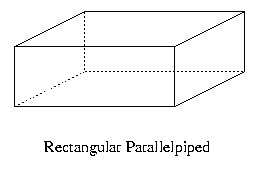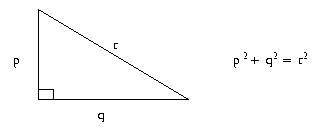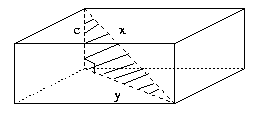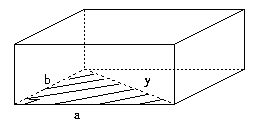The management asked its engineers to solve the problem. They spent much time and money in devising an X-ray machine with high-res monitors manned by staff to watch all the boxes on the line to make sure they weren't empty.
A workman hearing about this, came up with another solution. He got a powerful industrial fan and pointed it at the assembly line. As each soap box passed the fan, the empty boxes were blown off the line. Moral: the simplest solution is usually the best!
In Chinese the character for danger and opportunity is the same. Well maybe not but it sounds good!
A study in the Personality and Social Psychology Bulletin suggests you are more likely to succeed if you solve a difficult problem on another person’s behalf rather than for yourself. One of the problems was:
A prisoner was attempting to escape from a tower. He found a rope in his cell that was half as long enough to permit him to reach the ground safely. He divided the rope in half, tied the two parts together, and escaped. How could he have done this?
Students were asked to think of either themselves or a stranger stuck in the tower. 66% of the students who imagined a stranger in the tower, found the solution compared with 48% of those who envisaged themselves in the tower. THe authors said if we imagine that our problems belong to someone else, we might find better solutions. The solution, by the way is to split the rope lengthwise.
It's not that I'm so smart, it's just that I stay with problems longer.
Albert Einstein
Leaders are problem solvers by talent and temperament, and by choice.
Harlan Cleveland
Problems are only opportunities in work clothes.
Henri Kaiser
Difficulties are opportunities to better things; they
are stepping-stones to greater experience.... When one door closes,
another always opens.
Brian Adams
Every exit is an entry somewhere else.
Tom Stoppard
There are no foolish questions and no man becomes a fool until he has stopped asking questions.
Saul Steinberg
The most serious mistakes are not being made as a
result of wrong answers. The truly dangerous thing is asking the wrong
questions.
Peter Drucker
It is better to know some of the questions than all of the answers.
James Thurber
The mere formulation of a problem is far more often essential than its solution.
Albert Einstein
For every failure, there's an alternative course of
action. You just have to find it. When you come to a roadblock, take a
detour.
Mary Kay Ash
When life gives you a lemon, make lemonade.If you really want something you can figure out how to make it happen.
Cher
The creation of a thousand forests is in one acorn.
Ralph Waldo Emerson
Whether you believe you can, or whether you believe you can't, you're absolutely right.
Henry Ford
Never doubt that a small group of thoughtful,
committed citizens can change the world. Indeed it's the only thing that
ever has.
Margaret Mead
It is easier to tone down a wild idea than to think up a new one.
Alex Osborne
The best way to get a good idea is to get a lot of ideas.
Linus Pauling
Even if you are on the right track, you will get run over if you just stand there.
Will Rogers
The human mind is like a parachute - it functions better when it's open.
Cole's Rules
The man with a new idea is a crank - until the idea succeeds.
Mark Twain
Martin Luther King said "I have a dream", not "I have a plan. Example 1
This is an example in which you can find a solution once you analyze and understand the unknowns and data.
Problem: A survey of TV viewers shows the following results:
To the question "Do you watch comedies ?", 352 answered "Yes".,
To the question "Do you watch sports ?", 277 answered "Yes", and
To the question "Do you watch both comedies and sports ?", 129 answered "Yes".
Given these data, find, among people who watch at least one of comedies and sports, percentages of people who watch at least one of comedies and sports watch only comedies, only sports, and both comedies and sports.
Let us try to solve this problem following the framework presented above.
Understanding the Problem: This is a "find" type problem. So we try to identify unknowns, data and conditions.
The unknowns are the percentage of people who watch only comedies, the percentage of people who watch only sports, and the percentage of people who watch both comedies and sports.
The data are the three numbers: 352, 277 and 129, representing the number of people who watch comedies, sports, and both comedies and sports, respectively. Note that 352 includes people who watch both comedies and sports as well as people who watch only comedies. Similarly for 277.
The conditions are not explicitly given in the problem statement. But one can see that the percentages must add up to 100, and they must be nonnegative.
Devising a Solution Plan: Here we first examine the principal parts in detail.
First let us consider the unknowns in more detail. To calculate the percentage of the people who watch only comedies, for example, we need the number of people who watch at least one of comedies and sports, and the number of people who watch only comedies. Thus actually two unknowns are involved in each of the required percentages, and the real unknowns are the number of people in each of the categories, and the number of people who watch at least one of comedies and sports.
Next let us look at the data. First the number 352 is the number of people who watch comedies. But that is not necessarily that of the people who watch only comedies. It includes that and the number of people who watch both comedies and sports. Similarly for the second number 277.
Let us use symbols to represent each of the unknowns: Let C represent the number of people who watch only comedies, S that of the people who watch only sports, and T that of the people who watch at least one of those programs.
Then we have the following relationships among the unknowns:
C + 129 = 352
S + 129 = 277
C + S + 129 = T
From these equations we can easily obtain C = 223, S = 148, and T = 500 .
Thus the required percentages are 44.6%, 29.6%, and 25.8%, respectively.
All we had to do to solve this problem is to analyze relationships between the data and the unknowns, that is, nothing much beyond "understanding the problem".
Next -- Problem Solving -- Example 2
Back to Schedule
Back to Table of Contents
Example 2
This is a problem which you can solve using similar known results.
Problem: Find the (length of) diagonal of a rectangular parallelepiped given its length, width and height.
Again let us try to solve this problem following the framework presented above.
Understanding the Problem: This is a "find" type problem. So we try to identify unknowns, data and conditions.
The unknown is the diagonal of a rectangular parallelepiped, and the data are its length, width and height. Again there are no explicitly stated conditions. But the unknown and data must all be a positive number.
Before proceeding to the next phase, let us make sure that we understand the terminologies.
First a rectangular parallelepiped is a box with rectangular faces like a cube except that the faces are not necessarily a square but a rectangle as shown below.

Next a diagonal of a rectangular parallelepiped is the line that connects its two vertices (corner points) that are not on the same plane. It is shown in the figure below.

Devising a Solution Plan: Here we first try to find relevant facts. Relevant facts often involve the same or similar words or concepts. Since the unknown is a diagonal, we look for facts concerning diagonal. Note that drawing figures here is quite helpful.
One of the facts that immediately comes to our mind in this problem is Pythagoras' theorem. It has to do with right triangles and is shown below.

Let us try to see whether or not this theorem helps. To use this theorem, we need a right triangle involving a diagonal of a parallelepiped. As we can see below, there is a right triangle with a diagonal x as its hypotenuse.

However, the triangle here involves two unknowns: x and y. Since x is what we are looking for, we need to find the value of y. To find y, we note another right triangle shown below.

Applying Pythagoras' theorem again, we can obtain the value of y.
Thus y2 = a2 + b2
is obtained from the second triangle, and
x2 = c2 + y2
is derived from the first triangle.
From these two equations, we can find that x is equal to the positive square root of a2 + b2 + c2 .
No comments:
Post a Comment